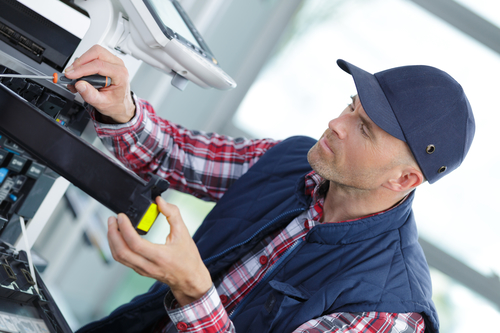“Don’t let your printer know you are in a hurry it can smell fear.”
2017 is coming to an end and the start of a new year will bring new projects and a lot of work. One thing that will put a monkey wrench into getting your work done is a malfunctioning copy machine. Right now, is a fantastic time to set a New Year’s resolution for printer maintenance.
We’d love for you to contact us at Common Sense Business Solutions to give your copy machine a much-needed tune up. But, if you want to do it yourself first, here is a nice set of guidelines for you to do it yourself. If these don’t help, we’d love for you to contact us, so we can be of service.
Clean your Copiers Printer Head
 If you don’t do this already, it’s most ideal to clean your printer heads at least one time per month. It’s pretty basic. All you have to do is, take the cartridges out and clean up the head with a warm cloth. Don’t be in a rush on this. Clean it with that warm cloth and allow some time for the head to dry before you start it up again. Don’t use an alcohol based cleaning product to do this. It can affect the overall production of your copier. A nice warm cloth is just fine.
If you don’t do this already, it’s most ideal to clean your printer heads at least one time per month. It’s pretty basic. All you have to do is, take the cartridges out and clean up the head with a warm cloth. Don’t be in a rush on this. Clean it with that warm cloth and allow some time for the head to dry before you start it up again. Don’t use an alcohol based cleaning product to do this. It can affect the overall production of your copier. A nice warm cloth is just fine.
Don’t ignore the inside
So much dust and daily wear and tear can build up and cause your copy machine to act up. Someone should always clean out the insides of your copy machine regularly for optimal performance. The best products to use are lint free cloths that have a little warm moisture in order to clean away the dustiness. The insides of a copier are delicate, so be gentle with it. Treat it like a new born baby and clean the affected areas gently. Even when you see the gunk is embedded, be as gentle as you can. Too much pressure can cause so many problems. We highly recommend a compressed air device to blow away the dust. This will bypass all worry of damaging the insides of your copy machine. No vacuum’s! Vacuum’s can sometimes be an uncontrolled pressure device and not clean it efficiently.
Pop it open
Pop open the hood of your copy machine or printer, and take a look for anything that could be jammed or broken. We’ve had many calls about paper jams and it’s in large part do to poor maintenance. A lot of people or companies will only maintain the toner cartridges, but under the hood is so important to maintain as well.
A lot of the new copy machines have automatic diagnostics capabilities so it’s vital to pay attention to them. Pay attention to the lights and on some copiers, there will be alert details. If those alert details are recognizable, go ahead and follow those instructions. If not, contact us or your copiers manufacturer. Don’t wait for the copier to break down. Let someone know what’s going on so they can replace any malfunctioning part before it’s too late.
We’ve seen it a million times, offices or people will replace parts on their copiers with cheap, non-original parts. Sometimes this is okay, but it’s in your best interest to not sacrifice your copiers overall working capability with a knock off product. Treat your copy machine well, and it’ll always work for you. Sacrificing quality, in the end, can cause you greater headaches in the long run.
Use the Correct Refill
My 79-year-old father still works, and he uses a copy machine every day. He’s always talking to me about how often he must refill his ink cartridges. First off, he has a knock off copy machine, but he’s old school so he says the cheaper printer is fine. But, this is the reason he must buy ink cartridges so often. He also buys the knock off cartridges that don’t live up to the style of printer he has. The quality isn’t there and he gets frustrated. I tell him, he needs to buy the correct ink cartridges for his printer and he’ll get the ideal desired quality for his printer and for his money. In the long run, using the optimal ink cartridge will help your copy machine run at its highest level.
In the end
Your copy machine needs to be used regularly to always be running at its peak performance. Maintaining your machine consists of not neglecting it and always cleaning it. Don’t buy knock off parts, don’t ignore the insides, and always clean the printer heads. If you don’t do these things at least once a month, a call to us or your printers manufacturer is inevitable. In the end, the more care you give to your printer, the less headaches you’ll receive.
Frequently Asked Questions
1. How often should I clean my printer head for optimal performance?
To keep your printer running smoothly, aim to clean the printer head at least once a month. This simple step can prevent clogs and improve print quality. Just remove the cartridges, use a warm, damp cloth (not alcohol-based), and gently wipe the head. Allow it to dry before restarting the printer to avoid ink smudges. Monthly maintenance can save you from costly repairs down the line!
2. Why is it important to clean the inside of my copier?
The inside of your copier gathers dust and debris that, if ignored, can mess with performance. Gently cleaning the interior with a lint-free cloth and a bit of moisture keeps everything in peak condition. Avoid vacuums as they can cause damage; instead, consider using compressed air to clear out tight spaces without harming sensitive components. Regular interior cleaning ensures your copier stays efficient and reliable.
3. What should I look for under the hood of my printer?
Open your printer’s hood to inspect for jammed paper or misaligned parts—common culprits behind printer issues. Many modern printers also offer diagnostic alerts, so check for any blinking lights or messages on the screen. If you’re unsure, it’s best to consult the manual or reach out to a professional before a small issue turns into a costly repair.
4. Can I use generic or non-brand parts in my copy machine?
While generic parts may be cheaper, they often lead to more problems. Non-brand components don’t always fit perfectly and can reduce your printer’s lifespan. Opt for manufacturer-approved parts to maintain print quality and avoid potential damage. A bit more investment in quality parts now can prevent costly breakdowns later.
5. What’s the best way to refill ink cartridges for my printer?
Using compatible ink cartridges specifically designed for your printer model makes a difference in print quality and longevity. Generic cartridges can sometimes be inconsistent, leading to faded prints or frequent replacements. To get the best value and avoid frequent refills, choose ink cartridges recommended by your printer’s manufacturer.
6. Why does my printer always seem to jam when I’m in a hurry?
Printers often jam at the worst moments due to factors like paper misalignment, low-quality paper, or infrequent maintenance. Avoid overloading the paper tray, use the recommended paper type, and clear any dust or debris inside. A little preventive care helps minimize these frustrating jams, especially when you’re on a deadline.
7. How can I make my copier last longer?
Simple maintenance habits can extend your copier’s life. Regularly clean the printer head, avoid generic parts, and clear dust from the interior. Following these steps can prevent common issues and ensure smoother operation. Think of it like car maintenance; a little attention goes a long way in avoiding breakdowns.
8. Are there any common signs my printer needs maintenance?
Yes, frequent paper jams, streaky prints, or unusual noises indicate it’s time for some upkeep. Pay attention to error messages or blinking lights—these can provide clues about specific problems. Addressing these small issues early prevents more significant and expensive repairs.
9. How can I avoid costly printer repairs?
Routine maintenance is your best friend when it comes to avoiding expensive printer repairs. Clean the printer head, use compatible ink cartridges, and handle any diagnostic alerts promptly. Investing a bit of time in regular care keeps your printer in top shape and spares you those surprise repair bills.
10. Should I turn off my printer when it’s not in use?
Yes, turning off your printer when not in use can help prevent ink from drying out and reduce wear on the machine. Leaving it on unnecessarily causes it to cycle and can lead to ink wastage. Powering down at the end of the day or during long breaks helps extend the life of your printer.


